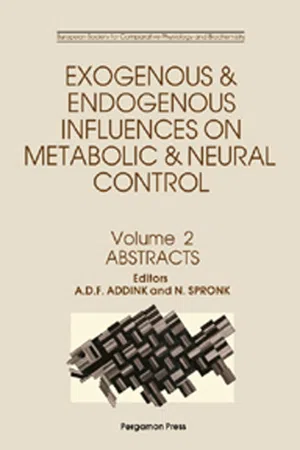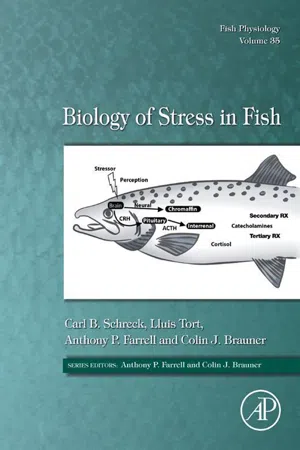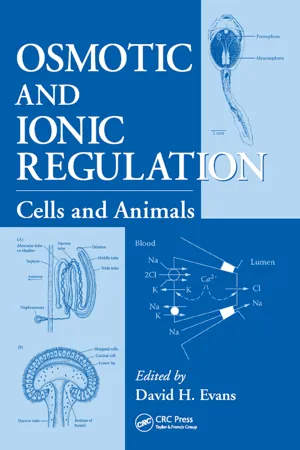Biological Sciences
Osmoregulation
Osmoregulation is the process by which organisms maintain the balance of water and solutes within their bodies. This involves regulating the concentration of fluids and electrolytes to ensure proper cell function and prevent dehydration or overhydration. Osmoregulation is crucial for the survival of organisms in diverse environments, allowing them to adapt to changes in water availability and salinity.
Written by Perlego with AI-assistance
Related key terms
6 Key excerpts on "Osmoregulation"
- eBook - ePub
Nutritional Biochemistry
From the Classroom to the Research Bench
- Sami Dridi(Author)
- 2022(Publication Date)
- Bentham Science Publishers(Publisher)
As I stated in Chapter 1, we drink because we are thirsty. Water is the most abundant constituent (50-60% of body weight) in the body. Approximately 55-75% of total body water is in the intracellular compartment, and the rest (~25-45%) in the extracellular compartment with a ratio of 1:3 intravascular (plasma) and extravascular (interstitial) spaces. Animals and humans continuously lose water by various physiological and cellular processes, including sweating, urination, and basal metabolic activity. To maintain water homeostasis and compensate for such losses, animals must drink sufficient water and ingest food from external sources. The maintenance of this in-and-out water balance represents a key homeostatic function for survival in all organisms. It specifically occurs through a balance between water intake/excretion and salt intake/excretion to keep the osmolality of the extracellular fluid at the optimal set-point. These processes are finely and tightly controlled at the entire organism level, including the peripheral sensory system and the central neural circuits. This chapter highlights recent advances in the field and describes the molecular mechanisms involved in the regulation of body fluid homeostasis.6.1. Organs Involved in Osmoregulation
Based on the Encyclopaedia, Osmoregulation is the maintenance by an organism of an internal balance between water and dissolved materials regardless of environmental conditions. As water and sodium are associated (where goes sodium, water soon follows whether by osmosis1 or bolus flows), all organisms have to regulate sodium and water in order to remain in homeostasis. Several organs, depending on vertebrate species, are involved in Osmoregulation to inhabit a wide variety of environments. With the exception of the mammals where the only kidney is involved, all other vertebrates use more than one organ/system to maintain the osmoregulatory homeostasis. Birds, for instance, use kidney, intestine, and salt glands for the maintenance of fluid and electrolyte balance. Reptiles utilize the kidney, intestine, bladder, and salt glands. Fish employ kidneys, intestine, bladder, and gills. In addition to the skin, amphibians make use of the same organs as fish. It is noteworthy that mammals can lose water and electrolytes via various routes, including skin, lungs, GI, but not for Osmoregulation. The mammalian urinary bladder is a urine storage organ and is not involved in Osmoregulation [1 ].Changes in body water/sodium balance disturb the extracellular fluid volume, which in turn affects arterial blood pressure. The CNS receives continuous inputs from the peripheral organs about the status of ECF osmolality, sodium concentration, sense of taste, fluid volume, and blood pressure, and acts accordingly to adjust the body fluid homeostasis.6.2. Water and Sodium Taste
The question that one might ask is whether water has a taste receptor or not. In Drosophila, water taste is mediated by ppk28, a member of the epithelial sodium channel/degenerin (ENac/Deg) family, which is expressed in gustatory receptor neurons [2 , 3 ]. In fact, functional studies showed that water consumption was reduced in flies lacking ppk28 [4 ]. In mammals, however, data are not conclusive, although electrophysiological studies have shown that water can stimulate taste nerves in several species, including cats and dogs [5 ]. Recent study showed that water and sour (acid) tastes are encoded by the same taste receptor cells [6 ]. Zocchi et al. [6 - eBook - ePub
Abstracts
Proceedings of the Third Congress of the European Society for Comparative Physiology and Biochemistry, August 31-September 3, 1981, Noordwijkerhout, Netherlands
- A. D. F. Addink, N. Spronk(Authors)
- 2013(Publication Date)
- Pergamon(Publisher)
Because of the disparate properties and ubiquitousness of water there is no chemical compound on earth which has a more catholic influence on living organisms. Because of this the control of water concentration within organisms is one of the most important and sometimes severe problems they face. For this reason organisms can be expected to have efficient osmoregulatory mechanisms. Further, as the required internal adjustments are most often geared to compensate for a constant challenge or but slowly changing conditions in the organisms environment we might also anticipate that the integration of osmoregulatory control is vested in chemical rather than nervous mechanisms. The voluminous literature now available on the control of osmoregulatory function strongly supports this contention.Numerous papers have been published which clearly establish a role of neuroendocrine mechanisms on hydromineral regulation in the more advanced invertebrates and it is inevitable that future exploration in this fascinating area will be extremely fruitful. Indeed, an understanding of endocrinology is rapidly becoming a sine qua non in any explanation of the physiology of Osmoregulation. Unfortunately there is insufficient time and space to address the invertebrate story. Instead we will restrict this lecture to the role of hormones in vertebrate Osmoregulation with particular emphasis on the fishes.With the possible exception of some of the myxinoid cyclostomes and an occasional chance or experimental encounter, aquatic organisms live in either hypoosmotic or hyperosmotic environments. For the purpose of this paper terrestrial organisms will be considered to occupy a media analogous to the latter. That is, they live in a media characterized by a low concentration of free water. The problem of Osmoregulation then is one of limiting the accumulation or loss of water such that variations in the concentration of tissue water remains within a permissable range.In the vertebrates a number of different hormones cooperate to regulate the exchange of water via several different target organs. The principle sites of exchange are the epithelia of the respiratory organs and gut, the kidney, the skin, and in some organisms, salt glands. The principal hormones involved include some neurohypophyseal peptides, cortical steroids and prolactin. The renin-angiotensin system, urophysis and the Stannius corpuscles have also been implicated in some of the aquatic organisms. This paper will attempt to survey the integrative role of these various hormones in the osmoregulatory control of vertebrates. - eBook - ePub
Invited Lectures
Proceedings of the Third Congress of the European Society for Comparative Physiology and Biochemistry, August 31-September 3, 1981, Noordwijkerhout, Netherlands
- A. D. F. Addink, N. Spronk(Authors)
- 2013(Publication Date)
- Pergamon(Publisher)
It is indeed of primary importance in keeping proper intracellular solutes concentrations; it is also essential in the maintenance of a proper architecture of the macromolecular supports to which many interacting components are bound. When considering cell volume control in eukaryotes, we are in fact concerned with two completely different types of processes. Both are however aiming at a same goal: avoiding osmotic gradients and therefore net movement of water between the cells and their surrounding fluid. In the first type of process, the intracellular fluid is actively kept close to isosmotic equilibrium with the extracellular one. The other mechanism implicates control of the osmolality of the extracellular fluid, whatever the osmolality, or the availability, of water in the external medium (figure 1). I would like to concentrate in this brief overview on some important features of these mechanisms as well as on some problems actually unsolved. For detailed information, I shall refer the reader to the papers presented at this symposium as well as to classical and also recent books and reviews in the field (Krogh, 1939 ; Potts and Parry, 1964 ; Keynes, 1971 ; Berridge and Oschman, 1972 ; Jungreis et al., 1977 ; Gupta et al., 1977 ; Macknight and Leaf, 1977 ; Barker Jorgensen and Skadhauge, 1978 ; Gilles, 1974, 1975, 1979, 1980 ; Maloiy, 1979 ; Kregenow, 1981). Figure 1 Osmoregulation in eukaryotes with a cell’s surrounding fluid separated from the external medium. Osmoregulation of the intracellular fluid (A): osmotic water transfer through plasma membranes following ajustment of the level of intracellular osmotic effectors. A is always kept close to isosmotic equilibrium with B. Osmoregulation of the extracellular fluid (B): osmotic water transfer essentially restricted to specific “salt transporting structures”. In many species, blood osmolality can be kept at a level different from that in the external medium (C) - Nicoladie Tam(Author)
- 0(Publication Date)
- Nicoladie Tam, Ph.D.(Publisher)
The renal system is evolved from simple regulation of osmosis to regulation of fluid and mineral balance, such that the concentration of various ions in the body is maintained (and kept at a constant level). Maintaining a constant concentration of the internal environment is essential for cellular functions.Why is Osmoregulation important for aquatic animals? Osmoregulation is particularly important for aquatic animals, since the animal will shrink or swell depending on the osmolality of the animal relative to the external osmolality Osmoregulation is less important in terrestrial animal, although osmolality still needs to be maintained for cellular function, otherwise bloating can occur. What is the primary organ of the renal system in vertebrates? Kidney is the major organ that regulates the fluid balance and filtration. The kidney contains functional units called nephrons for filtration, reabsorption and maintaining fluid balance. Why is it important to have to kidney to survive?It is because without the homeostatic regulation of bodily fluid, osmosis and filtration of materials such as toxins, the fluid concentration will go out of balance, and toxins will build up in the system.When the kidneys fail, a dialysis machine can be used to filter the blood as a temporary method to remove the toxins from the blood, and maintain the fluid and osmotic balance. However, the filtration capability of a dialysis machine is not as good as the kidneys, and transplant of kidney is required for long-term maintenance.What are the primary functions of the kidney? It filters blood, regulates the osmolality, water and ionic balance, reabsorb essential materials, and eliminate nitrogen wastes and other unwanted materials.Kidney performs these functions by filtering out most materials (even essential nutrients) from the blood except for large cells such as red blood cells and white blood cells. It then reabsorbs the essential materials (including water, nutrients, minerals, etc.), and discards the rest of the materials (including toxins, drugs, nitrogen wastes, etc.)- eBook - ePub
- Carl B. Schreck, Lluis Tort, Anthony Farrell, Colin Brauner(Authors)
- 2016(Publication Date)
- Academic Press(Publisher)
The blood of fish is rarely similar to the water in which they reside, and thus they are constantly exposed to some level of osmotic stress. In addition, physiological stressors and associated responses may have profound hydromineral balance consequences (Schreck and Tort, 2016; Chapter 1 in this volume). The osmotic gradient between the fish and its environment is perceived by osmosensors and transduced through the intracellular signaling pathway to effectors in the osmoregulatory organs and initiates both general and osmospecific adaptive responses over different time scales ranging from the immediate posttranslational modification to the longer-term transcriptional regulation of genes. The former includes alterations in the activity of transport proteins and osmolyte-producing enzymes, cytoskeletal organization, vesicular trafficking, and metabolism. Recent studies using genomewide, molecular physiological approaches, together with emerging model species, help identify new transcription factors and effector molecules that play critical roles in adaptation to osmotic stress. In this chapter, we will review recent data on the osmotic stress response in fishes at different levels of biological organization (from gene to whole organism) and at different time scales (from acute to chronic response) to highlight what is known and to suggest areas for further study.Keywords
Osmoregulation; hyperosmotic stress; hypoosmotic stress; osmosensing; ionocytes; hormonal regulation; transport proteins; energy metabolism1 Introduction
Fishes actively regulate the osmolality and ion levels of body fluids different from those of their environment either in freshwater or in seawater (Edwards and Marshall, 2012 ). Both osmolality and ion levels may be influenced by a range of stressors (Schreck and Tort, 2016 ; Chapter 1 in this volume) (Winberg et al., 2016 ; Chapter 2 in this volume). To maintain body fluid homeostasis, the sympathetic nervous system and the endocrine system (hypothalamic–pituitary–interrenal axis) are activated as a primary response to the stressors, which results in catecholamine release from the chromaffin cells and cortisol release from the steroidogenic cells of interrenal gland (Wendelaar Bonga, 1997 ) (Gorissen and Flik, 2016 ; Chapter 3 in this volume). These hormones act on the gills to regulate the activity of ion transport proteins within ionocytes and/or alter relative circulation to the respiratory arterio-arteriolar shunt and the osmoregulatory arterio-venous shunt (Olson, 2002 ), and these can significantly affect ion and water balance (Redding et al., 1984 ; Takei and Loretz, 2006 ). Cortisol also promotes longer-term adaptation in both freshwater and seawater by reorganizing the osmoregulatory organs despite the need to transport ions and water in opposite directions in these two water types (Wendelaar Bonga, 1997 ). In addition, changes in plasma glucose induced by these hormones alter the activity of ATP-driven ion pumps in the gills and other osmoregulatory organs (Bickler and Buck, 2007 ) (see Sadoul and Vijayan, 2016 ; Chapter 5 in this volume; and Section 5 - eBook - ePub
Osmotic and Ionic Regulation
Cells and Animals
- David H. Evans(Author)
- 2008(Publication Date)
- CRC Press(Publisher)
1 Osmoregulation: Some Principles of Water and Solute TransportDavid C. Dawson and Xuehong Liu
CONTENTS
I. Introduction: Maintaining the Nonequilibrium Composition of Leaky Compartments A. Nonequilibrium Cell Composition B. Selective Permeability and Energy Conversion C. The Pump–Leak Model: General Expectations D. Thermodynamic Tools and Equilibrium II. Water Permeation A. Driving Forces for Water Movement B. Mechanisms of Water Transport: Diffusion vs. Bulk Flow through Pores C. Crossing the Lipid Membrane by Solubility–Diffusion: The Equivalence of Osmotic and Diffusional Permeability D. Porous Membranes, Impermeant Solute E. Reflection Coefficient III. The Thermodynamics of Solute Pumps and Leaks A. The Driving Forces for Ionic Flows B. Diagnosing Active Transport C. Coupled, Energy-Converting Transport: Feasibility Analysis IV. Ion Flows A. Ion Permeability and Conductance B. Ionic Currents from Cells to Cell Layers C. Transepithelial Ionic Flows and the Short-Circuit Current V. A Glance at the Molecular Basis for Solute and Water Transport A. Channels and Transporters B. Selectivity Acknowledgments References Appendix 1. Osmotic Flow across a Lipid Membrane Appendix 2. Energetics of Sodium–Calcium Exchange I. INTRODUCTION: MAINTAINING THE NONEQUILIBRIUM COMPOSITION OF LEAKY COMPARTMENTS
Living cells have developed the ability to persist in the face of a fundamental contradiction. On the one hand, they preserve an internal composition that is an optimal milieu for metabolic processes that are essential to the maintenance of the living state and maintain the ability to regulate that composition as a defense against external perturbations. On the other hand, the maintenance of this environment and the nature of the associated regulatory processes demand that matter be continuously shuttled in and out of the cell. In other words, cells must maintain an internal composition that is constant but is also not in equilibrium with its environment. Cellular composition is maintained in a so-called “steady state” in the face of constant in and out traffic across the cell membrane.
Index pages curate the most relevant extracts from our library of academic textbooks. They’ve been created using an in-house natural language model (NLM), each adding context and meaning to key research topics.





